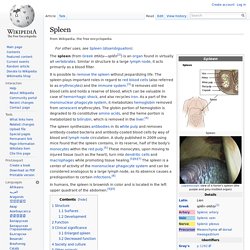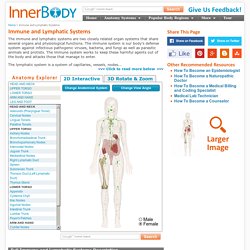

Spleen. The spleen synthesizes antibodies in its white pulp and removes antibody-coated bacteria and antibody-coated blood cells by way of blood and lymph node circulation.

A study published in 2009 using mice found that the spleen contains, in its reserve, half of the body's monocytes within the red pulp.[5] These monocytes, upon moving to injured tissue (such as the heart), turn into dendritic cells and macrophages while promoting tissue healing.[5][6][7] The spleen is a center of activity of the mononuclear phagocyte system and can be considered analogous to a large lymph node, as its absence causes a predisposition to certain infections.[8] In humans, the spleen is brownish in color and is located in the left upper quadrant of the abdomen.[4][9] Structure[edit] The spleen, in healthy adult humans, is approximately 7 centimetres (2.8 in) to 14 centimetres (5.5 in) in length. Surfaces[edit] Spleen and Lymphatic System. Listen Basic Anatomy The lymphatic system is a network of very small tubes (or vessels) that drain lymph fluid from all over the body.

The major parts of the lymph tissue are located in the bone marrow, spleen, thymus gland, lymph nodes, and the tonsils. The heart, lungs, intestines, liver, and skin also contain lymphatic tissue. One of the major lymphatic vessels is the thoracic duct, which begins near the lower part of the spine and collects lymph from the pelvis, abdomen, and lower chest. Lymph nodes are round or kidney-shaped, and can be up to 1 inch in diameter. The spleen helps control the amount of blood and blood cells that circulate through the body and helps destroy damaged cells. How A Healthy Lymph System Typically Works Carrying Away Waste Lymph fluid drains into lymph capillaries, which are tiny vessels. Tonsils and Adenoids. All About Adenoids. Lymphatic system. What is the Lymphatic System?

Click to enlarge Also see Cancer.gov "Shotty lymph nodes" refers to clusters of small swollen nodes. Shotty nodes may occur when the immune system is reacting to an infection -- it doesn't necessarily point toward any particular disease. "Bulky disease" generally describes a lymph node or extranodal tumor that measures greater than ten centimeters in any dimension. Immune and Lymphatic Systems – Anatomy Pictures and Information. [Continued from above] . . . and other organs that transport a fluid called lymph from the tissues as it returns to the bloodstream.

The lymphatic tissue of these organs filters and cleans the lymph of any debris, abnormal cells, or pathogens. The lymphatic system also transports fatty acids from the intestines to the circulatory system. Red Bone Marrow and LeukocytesRed bone marrow is a highly vascular tissue found in the spaces between trabeculae of spongy bone. It is mostly found in the ends of long bones and in the flat bones of the body. Lymphatic system. The lymphatic system is part of the circulatory system, comprising a network of lymphatic vessels that carry a clear fluid called lymph (from Latin lympha meaning water[1]) directionally towards the heart.

The lymphatic system was first described in the seventeenth century independently by Olaus Rudbeck and Thomas Bartholin. Unlike the cardiovascular system the lymphatic system is not a closed system. The human circulatory system processes an average of 20 litres of blood per day through capillary filtration which removes plasma while leaving the blood cells. Roughly 17 litres of the filtered plasma get reabsorbed directly into the blood vessels, while the remaining 3 litres are left behind in the interstitial fluid. One of the main functions of the lymph system is to provide an accessory route for these excess 3 litres per day to get returned to the blood.[2] Structure[edit] The central or primary lymphoid organs generate lymphocytes from immature progenitor cells. Thymus[edit] Lymph and immunity. Lymph system: MedlinePlus Medical Encyclopedia. The lymph system is a network of organs, lymph nodes, lymph ducts, and lymph vessels that make and move lymph from tissues to the bloodstream.

The lymph system is a major part of the body's immune system. Information Lymph is a clear-to-white fluid made of: White blood cells, especially lymphocytes, the cells that attack bacteria in the bloodFluid from the intestines called chyle, which contains proteins and fats Lymph nodes are soft, small, round- or bean-shaped structures. Lymph nodes make immune cells that help the body fight infection. The lymphatic system includes the tonsils, adenoids, spleen, and thymus. References Armitage JO. Update Date: 11/2/2012 Updated by: David C.